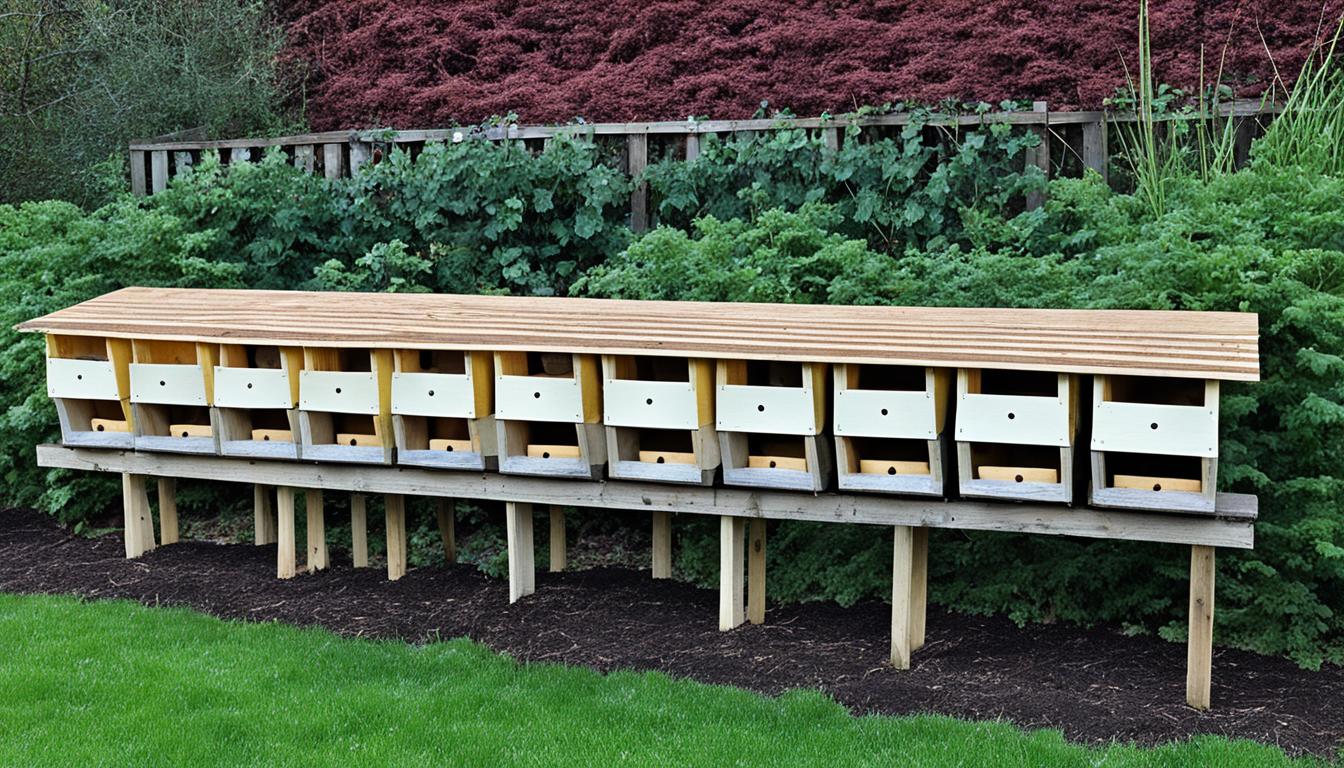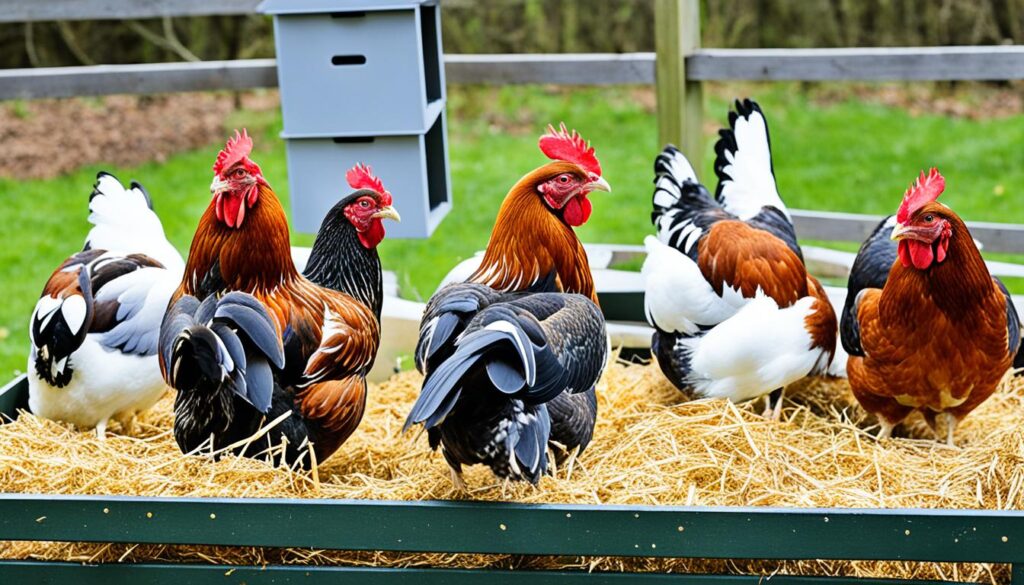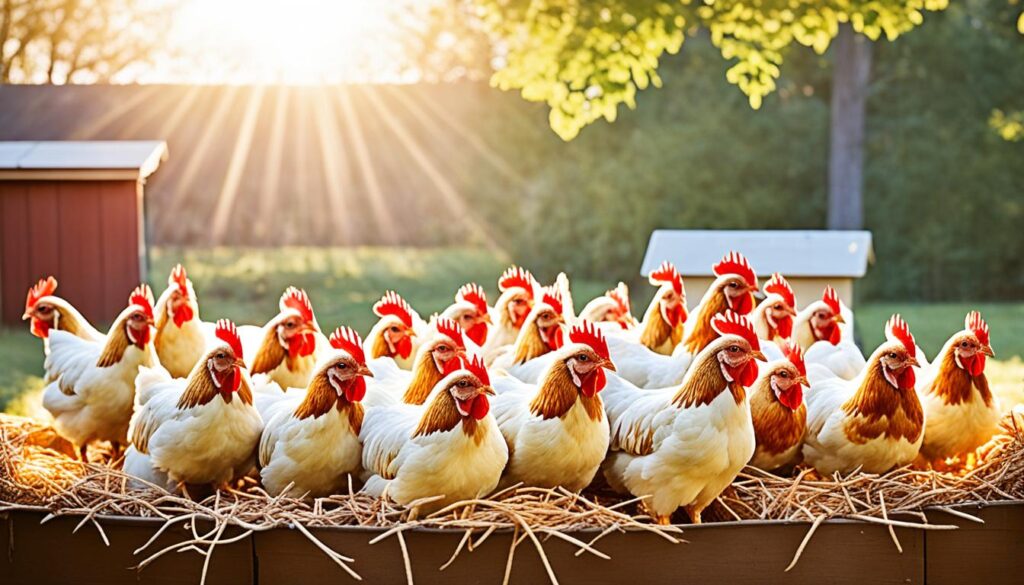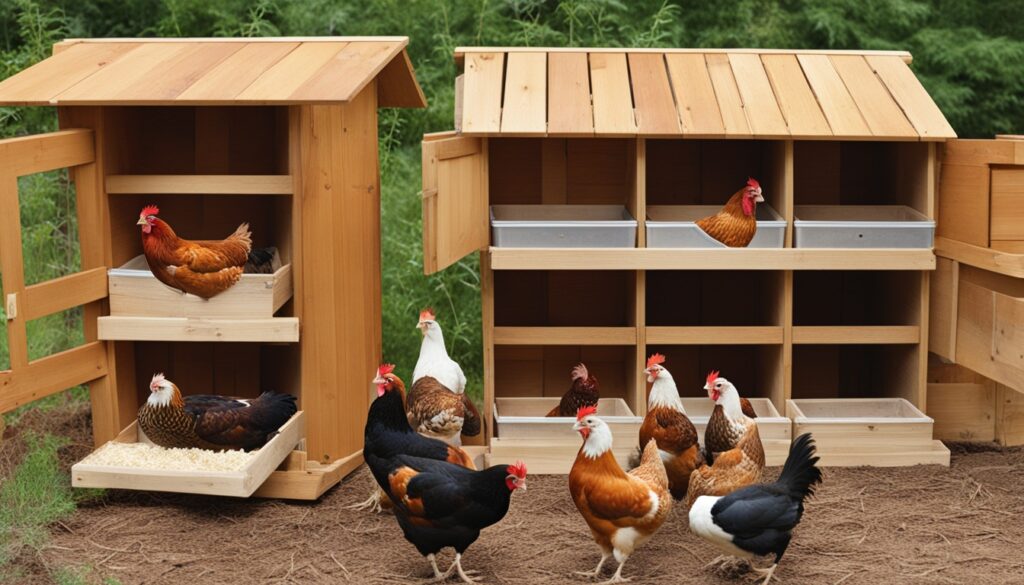Imagine waking up to a lovely sunrise and the sound of your happy hens. You feel excited about collecting fresh eggs. As a chicken keeper, you know the happiness that comes from giving your chickens a safe home. But how many nesting boxes does your chicken group really need?
The right number of nesting boxes is very important for your chickens’ well-being and the egg quality. A proper number of boxes mean every chicken has a private spot to lay eggs. This reduces stress and helps the hens lay eggs better.
Key Takeaways:
- One nest should be provided for every four to five hens to prevent overcrowding.
- Having properly designed, similar nests can reduce squabbles among hens.
- For six to eight hens, at least two nests are recommended, while ten to twelve hens should have at least three nests.
- Too many nesting boxes can take up unnecessary space and invite loitering.
- Too few nesting boxes can lead to egg trampling, breakages, and soiling.
Factors to Consider for Nesting Box Design
When creating chicken nesting boxes, it’s key to think about the hens’ needs for comfort and laying. Everything from what hens like to how easy they are to clean matters. It helps make the nesting boxes work well for everyone.
Creating a Cozy and Private Space
Hens look for dark and cozy spots to lay eggs. Placing the boxes under the coop windows can keep them dark. This makes a perfect place for eggs.
Size Matters
Nesting boxes should be just the right size. They need to give enough space for the hens to move. A 12-inch box is good, but bigger hens might need 14-16 inches.
Consistency is Key
Making sure all nesting boxes are the same makes hens happy. They can pick a favorite but won’t fight over them. This makes them feel relaxed and happy to lay eggs.
Choosing the Right Materials
There are many materials to make nesting boxes. People often use old milk crates or wooden crates. Whatever you choose, it should be easy to clean. This keeps everything tidy and the hens healthy.
Easy Cleaning Access
Cleaning the boxes is crucial. It keeps the hens happy and healthy. Designing the boxes so you can easily take off the backs or roofs helps a lot. You can then check for any broken eggs and keep the place clean.
Nesting Material for Cleanliness
The type of material you use for nesting is very important. Hay or straw are common choices. They are easy to keep in order and keep the eggs clean. This gives the hens a cozy place while avoiding dirty eggs.
A well-designed chicken nesting box can provide a comfortable and secluded space for hens to lay their eggs.
Determining the Number of Nesting Boxes
Deciding how many nesting boxes your chicken flock needs is crucial. Generally, one box for every two hens is a good rule. Yet, some find that one box for every three hens works well. Be careful not to have too few boxes. This might make hens lay eggs in bad spots. Bad spots could be areas where eggs get dirty or broken.
Watching how your hens prefer certain boxes can guide you. Hens often have their favorite places to lay eggs. You can make them happier by providing what they like. If you want to support brooding, extra nesting boxes are smart. Broody hens take up a nest to care for their eggs. Having more boxes stops fights over nests.
If your space is tight, stack or spread out the boxes to fit more. This helps every hen find a cozy place to lay. You can also try ground-level boxes for more room. But remember, gathering eggs from low nests might be harder.
Considering broody hens and avoiding overcrowding are always important. By keeping the rules in mind and knowing what your hens like, you can make a great home for them. A happy hen lays more eggs!
Coop Size Considerations and Cleaning
Planning or updating your coop’s size matters a lot. Think about how many chickens you have and might have later on. A bigger coop from the start means there’s plenty of room for each chicken and their nesting boxes.
Don’t forget about nesting box space when choosing coop sizes. Hens need enough room to lay their eggs easily. With room, they won’t feel confined or anxious about laying eggs.
Cleaning the coop’s nesting boxes often is key for your chickens’ health and safety. Make sure you can easily take the boxes out for cleaning. Being able to reach the back or roof helps find and remove any bad eggs.
Letting the sun sanitize your coop is a smart, natural way. Sunlight kills off germs, making the coop cleaner. Try to put your coop where it can get a lot of sun. That way, you won’t need as many chemical cleaners.
“A clean coop keeps your chickens healthy and their eggs safe to eat. Regularly clean the nesting boxes to stop germs and keep your chickens safe.”
So, think about coop size, space, and keeping it clean. These steps are vital for your chickens’ health and egg production. Doing these things right makes a better place for your flock to live and thrive.
Nest Box Preferences and Individual Hen Choices
Chickens have their favorite nest boxes in a flock. The style and location of nest boxes matter to them. To keep peace, make sure there’s a variety of nest boxes available for your hens.
Even with plenty of choices, some hens will pick the same box to lay eggs. This is normal and shouldn’t be interrupted. Just watch that it’s not causing any problems.
Watch how your chickens use their space. You might need to move, add, or change nest boxes. This helps to make sure every hen is happy with her nest spot.
“Understanding the nesting box preferences of your hens is key to maintaining a peaceful and productive coop environment. Providing ample options ensures that each hen has a comfortable space to lay her eggs, minimizing stress and competition.”
Give your hens plenty of nest box choices. This stops fights over nests and keeps the flock happy. It also means your chickens will lay eggs well and be healthy.
Try using different nest box designs and places. This makes your hens curious and helps them find their favorite spot.
Keep the chosen nest boxes clean and comfy. Clean them regularly and give the right stuff for nests. This is crucial to avoid bad eggs.
Vary the nest box types to see what your hens like. Use different materials, sizes, and places. This way, each hen can find a space that suits her.
Next, we will discuss the considerations and strategies for allocating nesting boxes to broody hens in Section 6.
Broody Hens and Nest Box Allocation
Broody hens, those eager to hatch eggs, have their favorite spots. To keep peace in the coop, it’s smart to have more than one nesting box for them. This makes sure non-broody hens still have places to lay eggs. It helps stop fights and keeps everyone happy.
When the coop is short on space, you can work smarter. You might stack the nesting boxes, saving floor space. This keeps everyone happy. Broody hens get their own spot, and others can still lay eggs in peace.
Or, you could make different areas for nesting by adding curtains or dividers. This gives each group their own private space to lay. Both broody and non-broody hens can then find a spot without squabbles.
Having a plan for nesting boxes is good for the chickens. It makes the coop a stress-free place for all. By setting things up right, you help everyone live well together.
“By providing multiple nesting boxes for broody hens, we can avoid conflicts and frustration within the flock, creating a peaceful coexistence for all hens.” – [Author Name]
Nesting Material, Cleanliness, and Egg Quality
It’s key to pick the right nesting material for clean boxes and good eggs. Many chicken keepers choose hay or straw because it’s easy to keep neat and clean.
“Hay or straw is easier to keep organized and clean, which contributes to maintaining hygienic nesting boxes.”
With hay or straw, hens make a cozy space to lay eggs. This makes them feel safe and sure about where to lay their eggs.
It’s vital to keep nesting boxes fresh to prevent egg mess. Eggs get dirty easily, which is not only gross but also means more work to clean them for eating or selling.
By changing out bedding often, you stop eggs from getting dirty. This keeps eggs cleaner, avoiding bad bacteria and sickness that could affect the eggs or your hens.
Choosing the right bedding and refreshing it regularly keeps eggs clean and consumers happy. It’s a key part of being a successful chicken keeper.
Conclusion
Finding the best chicken nesting boxes is key for happy, productive hens. Aim for a ratio of one box for every two to three hens to avoid overcrowding. This way, each hen has a good spot to lay eggs. Knowing what your hens like and keeping the boxes clean improves their experience.
A good nesting spot means more eggs and happier hens. Choose boxes that are cozy, dark, and private. Clean them often and use fresh nesting material to keep the eggs clean. If your hens are comfortable, they’ll lay more and better eggs.
Picking the right nesting boxes is important for your flock. Select boxes that are the right size and layout for your hens. By watching your flock and making adjustments, you’ll find the perfect match. This ensures your chickens lay eggs in a safe, happy space.



